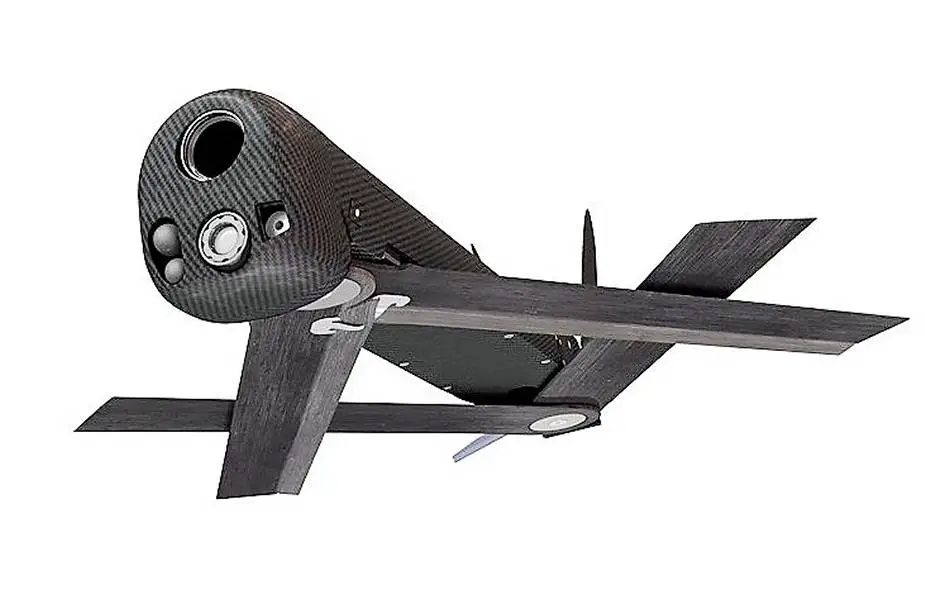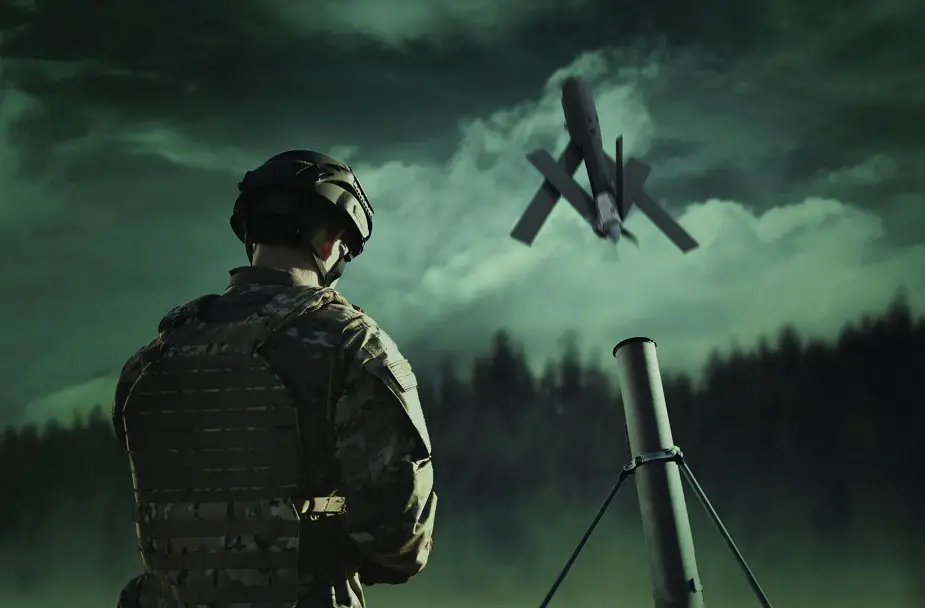U.S. President Joe Biden considers giving devastating Aerovironment Switchblade loitering munition ('kamikaze' drones) to the Ukrainians as part of a new $800Mn arms package he unveiled on March 16 as Zelensky pleaded with the U.S. Congress the same day for more weapons to defend his country against the Russian invaders.
Follow Army Recognition on Google News at this link

Backpackable and rapidly deployable from air, sea or ground platforms, Switchblade 300 delivers increased warfighter lethality with real-time GPS coordinates and video for precise targeting with low collateral effects (Picture source: Aerovironment)
The AeroVironment Switchblade is a miniature-sized loitering munition drone developed by AeroVironment. It is designed as a "kamikaze drone", being able to crash into its target with an explosive warhead to destroy it. The Switchblade is small enough to be carried in a backpack and can be launched from a variety of ground, maritime, and air platforms. Two variants exist, the Switchblade 300 and the Switchblade 600.
Supporting conventional or special operations forces in the field or from fixed defensive positions, the combat-proven Switchblade 300 with a patented wave-off feature is the ideal loitering missile for use against beyond-line-of-sight targets. Backpackable and rapidly deployable from air, sea or ground platforms, Switchblade 300 delivers increased warfighter lethality with real-time GPS coordinates and video for precise targeting with low collateral effects. It was designed and is produced by Washington DC-based AeroVironment. This terribly efficient weapon would be part of a huge package of military aid approved for Ukraine by Joe Biden.
The lighter Switchblade 300 is intended to kill people in the open and passengers in a vehicle. This small, lightweight and relatively cheap 'kamikaze' drone is said to be the same weapon that killed Iranian commander Qasem Soleimani under Donald Trump's administration in 2020.
The most powerful of the two Switchblades, the Switchblade 600, weighs 50lbs and can hover over a target for 40 minutes before darting down at speeds of 115mph, piercing armor and destroying a tank. It weighs only 5.5lbs but can travel for six miles, hover for 15 minutes, and then dive down to a target at 100mph.
Both Switchblades are designed to be easily portable, fitting into a rucksack and fired from a tube set. They were chosen for their ease-of-use, and because operators require comparatively little training before use.
But many questions remain about the Biden administration’s proposal to supply Switchblade [one or both versions] to Ukraine’s armed forces, Boyko Nikolov writes in Bulgarian Military. Most of them are related to the technological secrecy of the company, how much the White House is ready to risk sending such weapons to Ukraine, and how quickly AeroVironment would produce a certain quantity of Switchblades. If Ukraine receives some, they will become the most significant weapon used against the Russian aggressor. BulgarianMilitary.com spoke to its sources at the Pentagon and learned that despite the secrecy surrounding the Switchblade 600, this weapon was used for precision operations by US forces in Afghanistan. No further details were given.

Switchblade 300 (Picture source: Aerovironment)
Switchblade 300
The Switchblade 300 is designed as an expendable UAV to increase precision firepower for platoon-sized infantry units. It is 2 ft (610 mm) long and weighs 6 lb (2.7 kg) including the carrying case and launcher, making it small and light enough for one soldier to carry. The Switchblade is folded up inside a tube with wings unfolding once it gets airborne. It can be controlled up to 10 km (6.2 mi) but its small size limits its endurance to 10 minutes. This makes it unsuited for scouting roles, but it is useful for inexpensively engaging long-range targets and assisting in relieving units pinned down by the enemy fire. The Switchblade uses a color camera and GPS locating to identify, track, and engage targets, as well as being able to be pre-programmed on a collision course. Its warhead has an explosive charge equivalent to a 40mm grenade to destroy light armored vehicles and personnel. If a situation causes a strike to be called off, the operator can call off the Switchblade and re-target it. The aircraft is propelled by an electric engine, so its small size and silent flight make it extremely difficult to detect or try to intercept, enabling it to close in on a target at 85 knots (98 mph; 157 km/h). The Switchblade uses the same Ground Control Station (GCS) as other AeroVironment UAVs including the Wasp, RQ-11 Raven, and RQ-20 Puma. This creates a commonality and the potential for teaming of longer-endurance small UAVs to recon for targets, then having the Switchblade attack once they are identified with the same controller.
U.S. Army regulations categorize the Switchblade as a missile rather than a drone, and the term "loitering munition" is preferred to describe it; unlike UAVs, it is not recoverable once launched. Its operation is similar to that of the wireless TOW missile, through a fly-by-radio frequency signal, the only difference being the TOW fires straight and doesn't loiter, but both have the same operator-in-the-loop characteristics.
Aside from being used against ground targets, SRC Inc. has written software to combine the Switchblade with sensors to be able to intercept hostile UAVs. The Switchblade is used alongside an existing counter-artillery radar and IED jamming system, all of which can be towed by Humvees. Interception of an enemy drone occurs in layers of defenses: if a drone gets through covering jet fighters or is too small to be targeted by them, it is picked up by the fire-finding radar; once detected, the jammer performs electronic warfare to break its data-link; if the drone resists EW, the Switchblade is launched to physically impact and destroy it.
A Switchblade 300 costs $6,000, versus $150,000 for a Hellfire missile fired from a conventional Predator or Reaper attack drone.

Switchblade 600 (Picture source: Aerovironment)
Switchblade 600
By late 2018, AeroVironment was working on developing an anti-armor version of the Switchblade that would be larger to carry a bigger munition. In March 2020, AeroVironment revealed it had flight-tested a larger version of the Switchblade the previous year. The flights were described as "successful" for the larger design that "flies further and longer, and carries much bigger mission effects or mission impact." Other large loitering munitions have incorporated armor-piercing warheads, so the larger Switchblade could be fitted with an anti-tank warhead while having longer range and costing less than anti-tank missiles like the Javelin.
In October 2020, AeroVironment unveiled the Switchblade 600 loitering munition. The larger system weighs 50 lb (23 kg) but is still man-portable and can be set up in 10 minutes. It is designed to fly out to 40 km (25 mi) in 20 minutes, then loiter for another 20 minutes (giving it an 80 km (50 mi) total range) and attack at a 115 mph (185 km/h) dash speed, carrying an anti-armor warhead designed to neutralize armored vehicles. A touchscreen tablet-based fire control system can manually or autonomously control the munition, and it is secured through onboard encrypted data links and Selective Availability Anti-Spoofing Module GPS with a patented wave-off capability. The Switchblade 600 was developed to meet requirements in an Army development program called Single Multi-Mission Attack Missile. By the time of its unveiling, it had undergone 60 test flights from ground launches against fixed and moving targets. Other methods could include a six-pack vehicle-mounted version and by air-launch.
On 31 March 2021, AeroVironment was awarded a USD26.1 million contract by USSOCOM for the Switchblade 600. The system addresses the United States Naval Special Warfare Command's Maritime Precision Engagement (MPE) requirement to engage asymmetric threats with Combatant Craft Medium (CCM) and Heavy (CCH) boats acting as host platforms.














